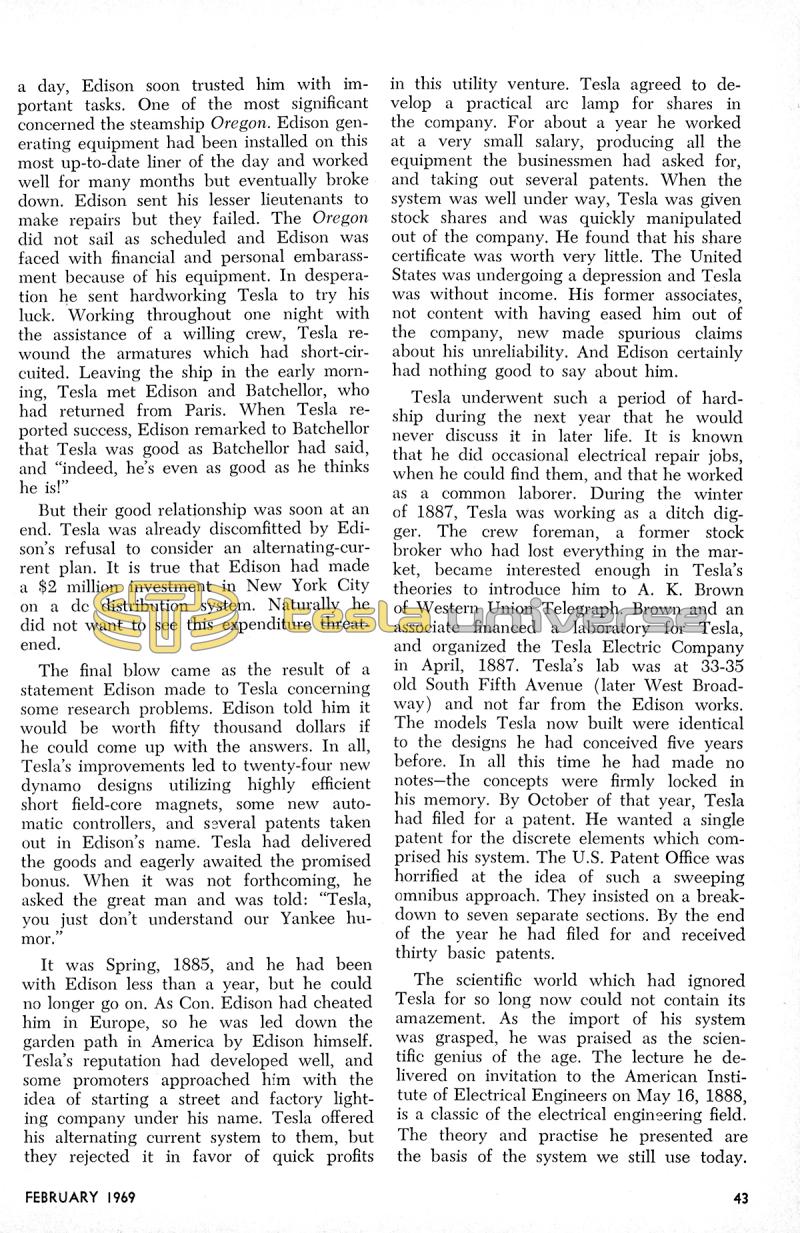
Nikola Tesla Articles
a day, Edison soon trusted him with important tasks. One of the most significant concerned the steamship Oregon. Edison generating equipment had been installed on this most up-to-date liner of the day and worked well for many months but eventually broke down. Edison sent his lesser lieutenants to make repairs but they failed. The Oregon did not sail as scheduled and Edison was faced with financial and personal embarrassment because of his equipment. In desperation he sent hardworking Tesla to try his luck. Working throughout one night with the assistance of a willing crew, Tesla rewound the armatures which had short-circuited. Leaving the ship in the early morning, Tesla met Edison and Batchelor, who had returned from Paris. When Tesla reported success, Edison remarked to Batchelor that Tesla was good as Batchelor had said, and "indeed, he's even as good as he thinks he is!"
But their good relationship was soon at an end. Tesla was already discomfitted by Edison's refusal to consider an alternating-current plan. It is true that Edison had made a $2 million investment in New York City on a de distribution system. Naturally he did not want to see this expenditure threatened.
The final blow came as the result of a statement Edison made to Tesla concerning some research problems. Edison told him it would be worth fifty thousand dollars if he could come up with the answers. In all, Tesla's improvements led to twenty-four new dynamo designs utilizing highly efficient short field-core magnets, some new automatic controllers, and several patents taken out in Edison's name. Tesla had delivered the goods and eagerly awaited the promised bonus. When it was not forthcoming, he asked the great man and was told: "Tesla, you just don't understand our Yankee humor.
It was Spring, 1885, and he had been with Edison less than a year, but he could no longer go on. As Con. Edison had cheated him in Europe, so he was led down the garden path in America by Edison himself. Tesla's reputation had developed well, and some promoters approached him with the idea of starting a street and factory lighting company under his name. Tesla offered his alternating current system to them, but they rejected it in favor of quick profits in this utility venture. Tesla agreed to develop a practical arc lamp for shares in the company. For about a year he worked at a very small salary, producing all the equipment the businessmen had asked for, and taking out several patents. When the system was well under way, Tesla was given stock shares and was quickly manipulated out of the company. He found that his share certificate was worth very little. The United States was undergoing a depression and Tesla was without income. His former associates, not content with having eased him out of the company, new made spurious claims about his unreliability. And Edison certainly had nothing good to say about him.
Tesla underwent such a period of hardship during the next year that he would never discuss it in later life. It is known that he did occasional electrical repair jobs, when he could find them, and that he worked as a common laborer. During the winter of 1887, Tesla was working as a ditch digger. The crew foreman, a former stock broker who had lost everything in the market, became interested enough in Tesla's theories to introduce him to A. K. Brown of Western Union Telegraph. Brown and an associate financed a laboratory for Tesla, and organized the Tesla Electric Company in April, 1887. Tesla's lab was at 33-35 old South Fifth Avenue (later West Broadway) and not far from the Edison works. The models Tesla now built were identical to the designs he had conceived five years before. In all this time he had made no notes-the concepts were firmly locked in his memory. By October of that year, Tesla had filed for a patent. He wanted a single patent for the discrete elements which comprised his system. The U.S. Patent Office was horrified at the idea of such a sweeping omnibus approach. They insisted on a breakdown to seven separate sections. By the end of the year he had filed for and received thirty basic patents.
The scientific world which had ignored Tesla for so long now could not contain its amazement. As the import of his system was grasped, he was praised as the scientific genius of the age. The lecture he delivered on invitation to the American Institute of Electrical Engineers on May 16, 1888, is a classic of the electrical engineering field. The theory and practise he presented are the basis of the system we still use today.
